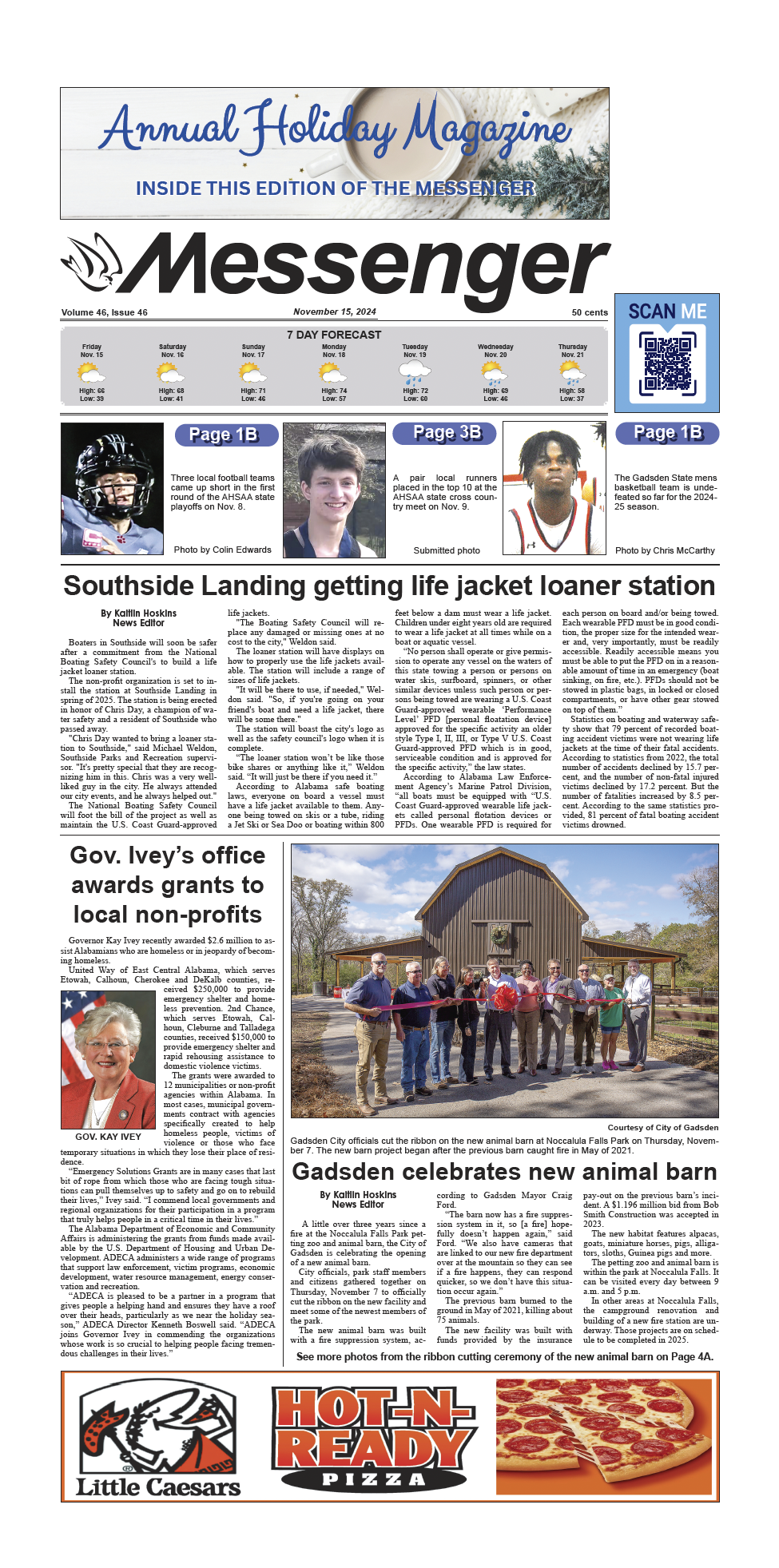For the next few weeks, The Vagabond will discuss some of the folks that settled in the area west of Attalla before the Cherokees were removed. This area was from around Highways 77 and 431 all the way up to Sand Valley Road.
The town occupies the site of an Indian village that was of considerable importance during the Creek War of 1813. Some folks say that Indian relics found in the vicinity are “Tsu-sanya-sah – Ruins-of-a-Great-City.” Nevertheless, the area featured some of the most unknown events in American history.
This week, the Vagabond discusses Silas Choate, who was born about 1780 in North Carolina and died about 1861 in Skin Bayou District, Cherokee Nation, Indian Territory. Where he is buried is unknown, but may be in a cemetery located in Dora, Ark.
More About Silas Choate:
Degree of Indian: None
Fact 1: 1817, Wills Valley, Alabama in the old Cherokee Nation.
Fact 2: May 1, 1835, arrived in Indian Territory on his the first trip out west.
Fact 3: Oct. 1, 1835, returned to Wills Valley, Ala., in the fall.
Fact 4: Silas and his family are removed out west on the Trail of Tears.
Fact 5: 1860: Silas is a farmer in Greenwood Junction, Cherokee Nation, Okla.
Silas was married in 1820 to Isabel Brown, a Cherokee Indian. The couple lived near the Tennessee River a few miles northeast of Guntersville. Silas then married Catherine Mccameron, a Cherokee Indian around 1828. She was the daughter of Samuel McCameron and Quatse (Ya-Somu). When Silas married Catherine, he became a Cherokee. Silas’ Cherokee name was Oo-ta-te-yin-tah. We do not know the meaning of his name.
By way of an educated assumption from Choate researchers who have been doing this for a long time, it is believed that Moses Choate was Silas’ father.
Silas Choate was a white inhabitant living on Indian lands when he was in this area. In 1848, in a sworn statement, Silas stated, “I am a white man with a Cherokee family.”
In 1906, Silas’ only surviving child stated that her father was white.
Silas had a brother named Sanders. There is a Sanders Choate listed in the 1820 Alabama Census in Shelby County. That location is no more than 50 miles from Wills Valley, where Silas lived in 1817.
According to a store ledger book found at the Etowah Historical Society, by 1835 Sanders was living in Wills Valley. That Sanders Choate was married and had one son and three daughters under 21 years of age.
The Cherokee Emigration Roll of 1817 shows that Silas Choate was registered as a person who wished reservations under the treaty of July 8, 1817. A report shows on Nov. 21, 1818, Silas Choate in right of his wife with three in the family. Their place of residence was listed as, “Near the ford on Wills Creek.”
Silas Choate was mentioned in the book Torchlights to the Cherokees by Robert Sparks Walker. In the chapter entitled Quotations From the Journal, there is this quotation regarding the establishment of the mission at Creek Path”
“April 13, 1820. Received a letter from brother Butrick, dated the 8 instant. It was truly welcome, as we had heard nothing from him since the 3d day after he left us, which is now a full month. The prospects at Creek Path are hopeful. When we left Brainerd, we lost our path, traveled until sometimes after dark, and came to a road near Little Meat’s. We stopped and were greatly refreshed by the kindness of our dear Cherokee friends. On Monday, we traveled to Mr. Pardue’s, visited Pathkiller on the way. On Tuesday to Mr. Burns; got a recruit of provisions. On Wednesday to a large hickory blown down by the wind, where we had a very comfortable lodging. Thence to Mr. Scott’s. Friday to a large white oak log in the woods, between Shoat’s and Cox’s. Sunday, to Captain J. Browns.”
In a statement attached to Richard Riley’s Miller application, Sanders said he and his parents came west in the spring of 1835 and his mother was dissatisfied. That fall, his father, Felix Riley, agreed to return to the east but sent his wife and baby son ahead with the Choate family. They arrived back in Wills Valley in Nov., 1835. Since there was only one Cherokee Choate family, this proves Baxter Choate’s statement, made in 1935, that the Choate family made two trips out west.
On the first Cherokee Emigration Register of 1835, the family was removed in wagons and steamboats by Lt. J. W. Harris and arrived in the new country on May 16, 1835. The register said that one family member died on the way.
On the second trip, before the round up by the soldiers that began May 25, 1838, a Lt. Edward Deas escorted several groups, including Choate and his family, out to the Indian Territory. These groups were made up of Cherokees who either realized the inevitable or were Ridge sympathizers and agreed to allow the army to escort them out.
In April of 1838, Deas took 250 Cherokees from the Alabama area. The families of Silas Choate, Sanders Choate, and Francis Hampton, Delilah Choate’s husband, are on that list. They had all been living at Turkey Town.
The group traveled to the Western Cherokee Nation in about two weeks. No lives were lost on the trip. This is the only group who had no deaths on the trial.
In an interview on March 19 1937, Silas’ grandson, Baxter Choate, also stated that Silas and family came west. They only stayed a short time and then returned to the Old Cherokee Nation. Later the family came west again.
When Silas came west the second time, he settled at Greenwood Junction, near the present state line of Oklahoma and Arkansas. Greenwood Junction does not exist today, but it was located just south of the present town of Dora, Arkansas/Oklahoma.
Early in life, Silas was in the War of 1812. He was mustered into service with the 1st Regiment commanded by Colonel John K. Wynn and Captain James Cole. The regiment participated in Andrew Jackson’s first campaign into Creek territory, where the army fought at the Battle of Talladega on Nov. 9, 1813.
After this, the 1817 Cherokee Land Cession included an option for those Cherokees wishing to remain east of the Mississippi River to obtain a 640-acre land grant. This marked the beginning of the Americans’ ultimately successful removal of the southeastern Indians by changing the manner in which the Cherokee perceived land ownership. Before this time all Cherokee land was “owned” in common by the tribe as a whole. Now, individuals became landowners. The grant constituted a life estate to the reservee, dependent upon the reservee maintaining possession of the land, with a right of passing the reserve on to the reservee’s heirs in fee simple.
On Oct. 2, 1826, on records it says, “Silas Choate of (Age: 46) of Chattooga: Purchase of Land. CNE Chattooga district.” This district included a wedge of now Georgia west of Rome, but was mainly in Alabama.
In 1833 – 1834, Silas (age 53) was in Wills Valley, Ala. The Land Valuations states: “Silas Choate and Wife Impts. at the lower end of Lookout Mountain called Matliffs [actually Ratliffs] old place on the Georgia road where Col. McCoy lives.”
By and before April 1838 (age 58), Silas was living in Turkey Town, Cherokee Nation East. From there, he left Turkey Town forever on the Trail of Tears to Cherokee Nation West.
Silas died around 1861, just as the Civil War was beginning. It is believed that Tim Choate of the Etowah County Commission is kin to Silas Choate.




